A Detailed Report on Organizational Conflict, Theories, and Solutions
VerifiedAdded on 2020/05/01
|18
|6686
|375
Report
AI Summary
This report provides a comprehensive overview of organizational conflict, exploring its definition as misunderstandings or disagreements arising from differing needs, interests, and values in the workplace. It delves into influencing factors such as unclear responsibilities, interpersonal relationships, and scarce resources, and examines various types of conflict, including task, process, and relationship conflicts. The report investigates the causes of conflict, including communication disruptions, misunderstandings, and lack of accountability. It then explores the Organizational Conflict Theory and Conflict Management Theory, detailing approaches such as avoidance, accommodation, compromise, competition, and collaboration. The report emphasizes the importance of proactively managing conflict to enhance productivity and foster a positive work environment, offering insights into the causes, types, and effective resolution strategies for organizational conflicts.
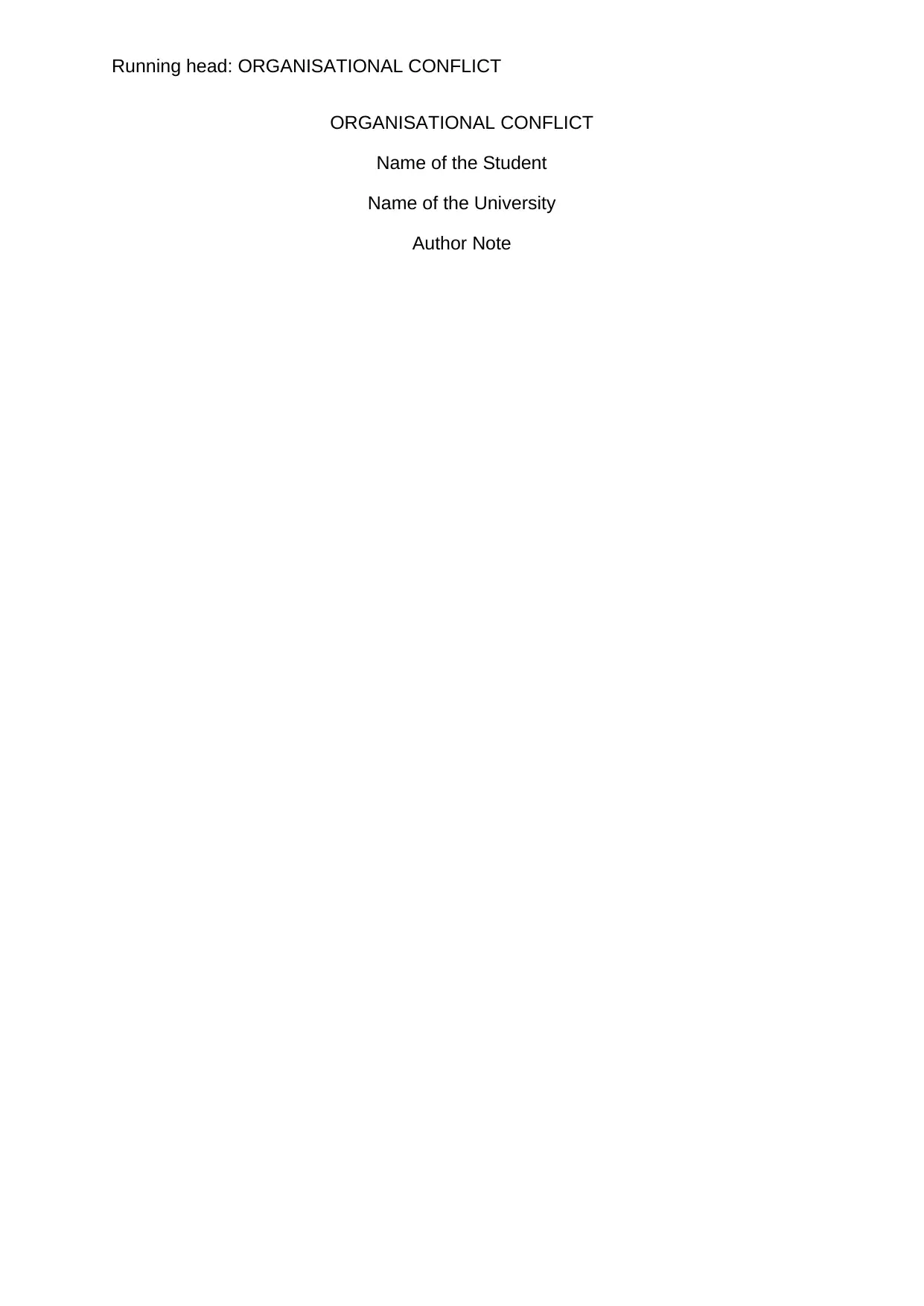
Running head: ORGANISATIONAL CONFLICT
ORGANISATIONAL CONFLICT
Name of the Student
Name of the University
Author Note
ORGANISATIONAL CONFLICT
Name of the Student
Name of the University
Author Note
Paraphrase This Document
Need a fresh take? Get an instant paraphrase of this document with our AI Paraphraser
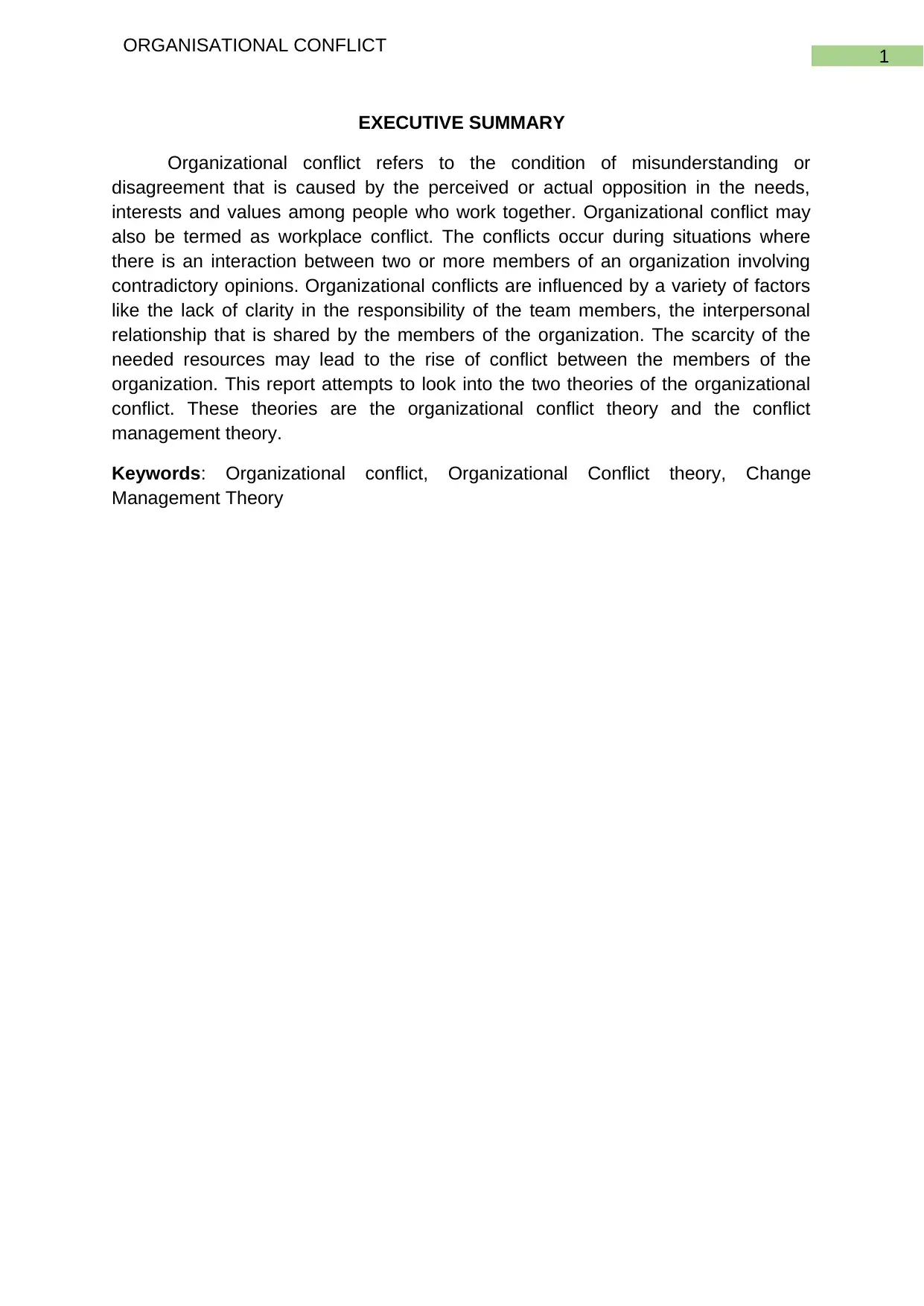
1
ORGANISATIONAL CONFLICT
EXECUTIVE SUMMARY
Organizational conflict refers to the condition of misunderstanding or
disagreement that is caused by the perceived or actual opposition in the needs,
interests and values among people who work together. Organizational conflict may
also be termed as workplace conflict. The conflicts occur during situations where
there is an interaction between two or more members of an organization involving
contradictory opinions. Organizational conflicts are influenced by a variety of factors
like the lack of clarity in the responsibility of the team members, the interpersonal
relationship that is shared by the members of the organization. The scarcity of the
needed resources may lead to the rise of conflict between the members of the
organization. This report attempts to look into the two theories of the organizational
conflict. These theories are the organizational conflict theory and the conflict
management theory.
Keywords: Organizational conflict, Organizational Conflict theory, Change
Management Theory
ORGANISATIONAL CONFLICT
EXECUTIVE SUMMARY
Organizational conflict refers to the condition of misunderstanding or
disagreement that is caused by the perceived or actual opposition in the needs,
interests and values among people who work together. Organizational conflict may
also be termed as workplace conflict. The conflicts occur during situations where
there is an interaction between two or more members of an organization involving
contradictory opinions. Organizational conflicts are influenced by a variety of factors
like the lack of clarity in the responsibility of the team members, the interpersonal
relationship that is shared by the members of the organization. The scarcity of the
needed resources may lead to the rise of conflict between the members of the
organization. This report attempts to look into the two theories of the organizational
conflict. These theories are the organizational conflict theory and the conflict
management theory.
Keywords: Organizational conflict, Organizational Conflict theory, Change
Management Theory
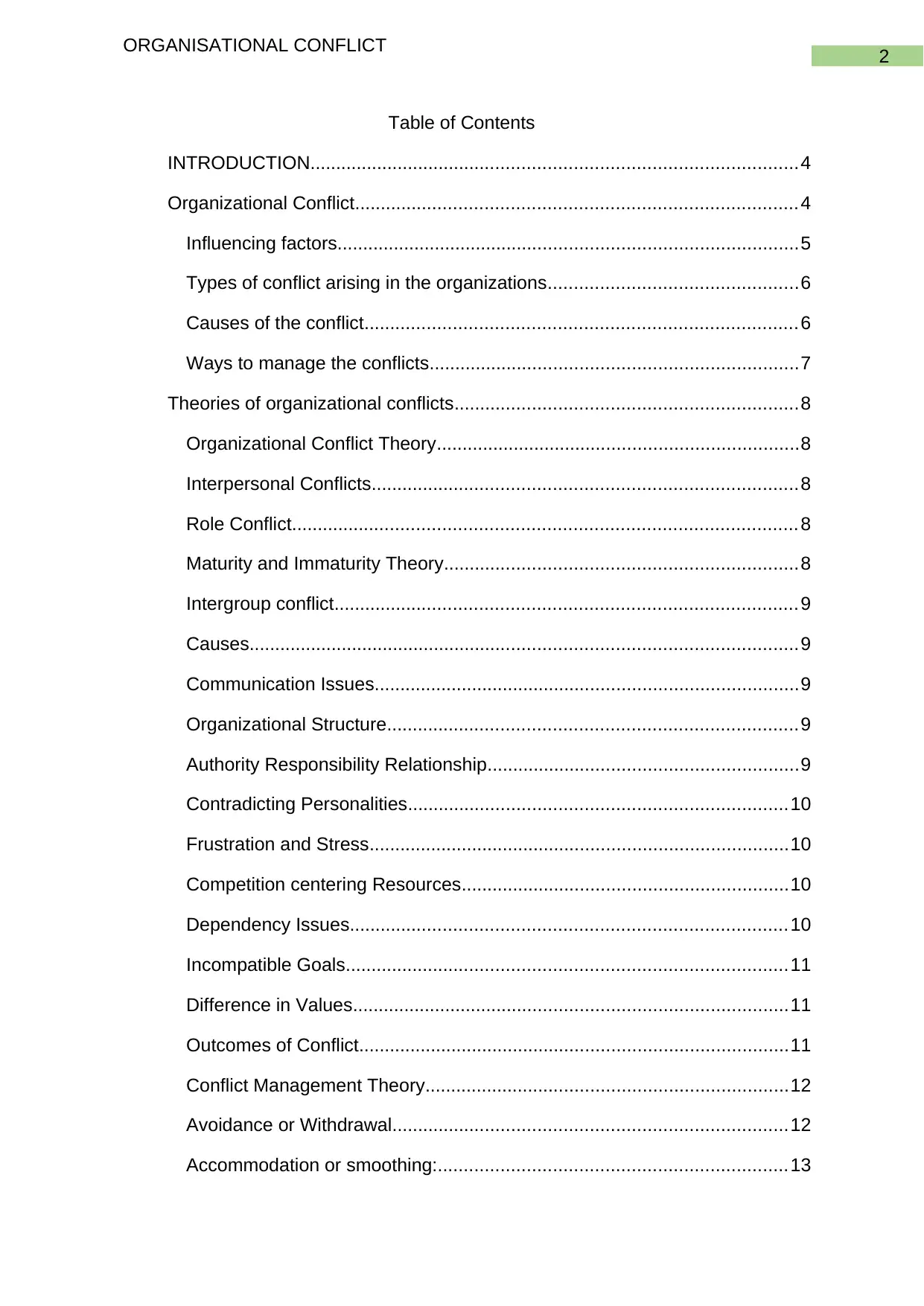
2
ORGANISATIONAL CONFLICT
Table of Contents
INTRODUCTION..............................................................................................4
Organizational Conflict.....................................................................................4
Influencing factors.........................................................................................5
Types of conflict arising in the organizations................................................6
Causes of the conflict...................................................................................6
Ways to manage the conflicts.......................................................................7
Theories of organizational conflicts..................................................................8
Organizational Conflict Theory......................................................................8
Interpersonal Conflicts..................................................................................8
Role Conflict................................................................................................. 8
Maturity and Immaturity Theory....................................................................8
Intergroup conflict.........................................................................................9
Causes..........................................................................................................9
Communication Issues..................................................................................9
Organizational Structure...............................................................................9
Authority Responsibility Relationship............................................................9
Contradicting Personalities.........................................................................10
Frustration and Stress.................................................................................10
Competition centering Resources...............................................................10
Dependency Issues....................................................................................10
Incompatible Goals.....................................................................................11
Difference in Values....................................................................................11
Outcomes of Conflict...................................................................................11
Conflict Management Theory......................................................................12
Avoidance or Withdrawal............................................................................12
Accommodation or smoothing:...................................................................13
ORGANISATIONAL CONFLICT
Table of Contents
INTRODUCTION..............................................................................................4
Organizational Conflict.....................................................................................4
Influencing factors.........................................................................................5
Types of conflict arising in the organizations................................................6
Causes of the conflict...................................................................................6
Ways to manage the conflicts.......................................................................7
Theories of organizational conflicts..................................................................8
Organizational Conflict Theory......................................................................8
Interpersonal Conflicts..................................................................................8
Role Conflict................................................................................................. 8
Maturity and Immaturity Theory....................................................................8
Intergroup conflict.........................................................................................9
Causes..........................................................................................................9
Communication Issues..................................................................................9
Organizational Structure...............................................................................9
Authority Responsibility Relationship............................................................9
Contradicting Personalities.........................................................................10
Frustration and Stress.................................................................................10
Competition centering Resources...............................................................10
Dependency Issues....................................................................................10
Incompatible Goals.....................................................................................11
Difference in Values....................................................................................11
Outcomes of Conflict...................................................................................11
Conflict Management Theory......................................................................12
Avoidance or Withdrawal............................................................................12
Accommodation or smoothing:...................................................................13
⊘ This is a preview!⊘
Do you want full access?
Subscribe today to unlock all pages.

Trusted by 1+ million students worldwide
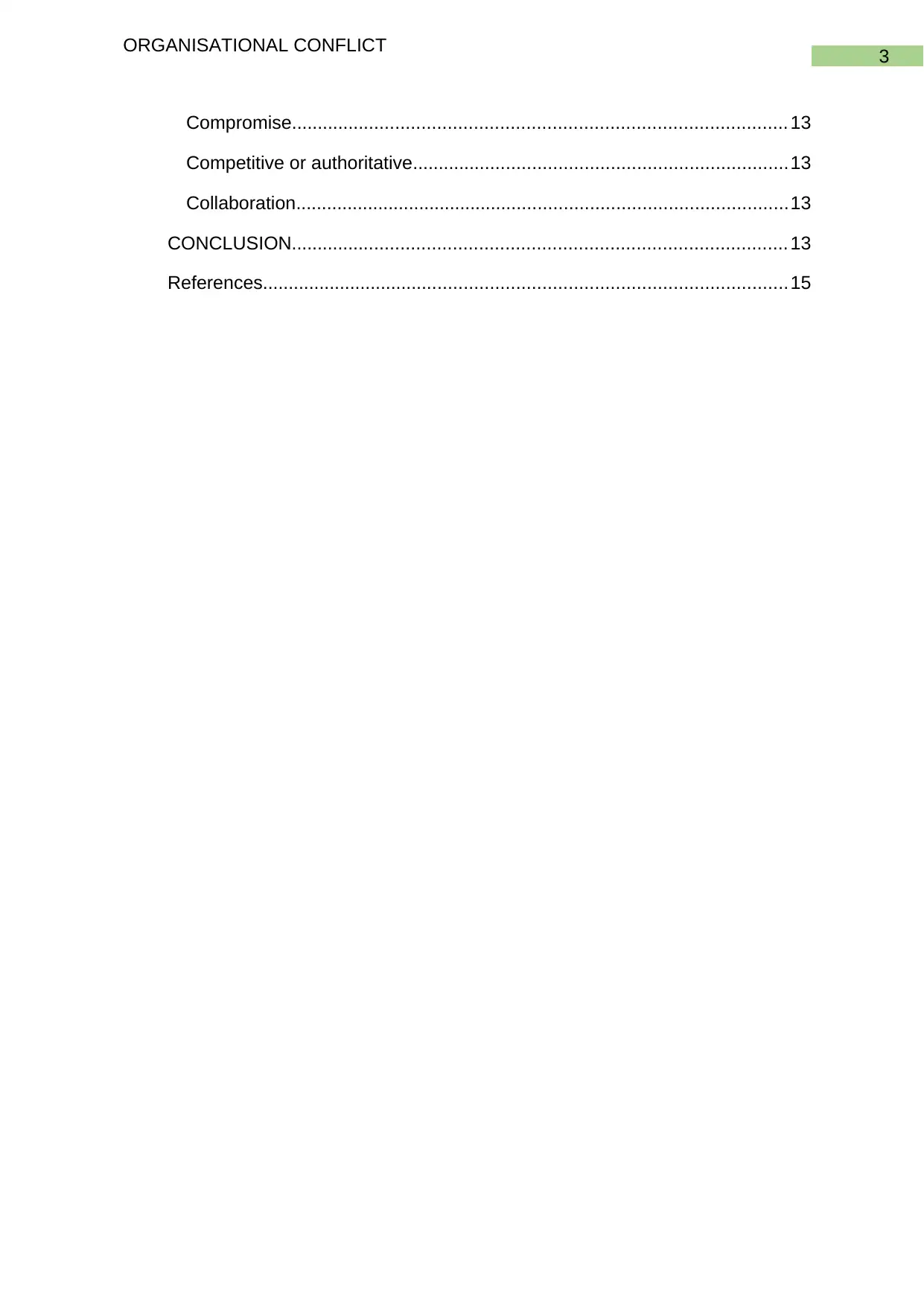
3
ORGANISATIONAL CONFLICT
Compromise............................................................................................... 13
Competitive or authoritative........................................................................13
Collaboration...............................................................................................13
CONCLUSION............................................................................................... 13
References.....................................................................................................15
ORGANISATIONAL CONFLICT
Compromise............................................................................................... 13
Competitive or authoritative........................................................................13
Collaboration...............................................................................................13
CONCLUSION............................................................................................... 13
References.....................................................................................................15
Paraphrase This Document
Need a fresh take? Get an instant paraphrase of this document with our AI Paraphraser
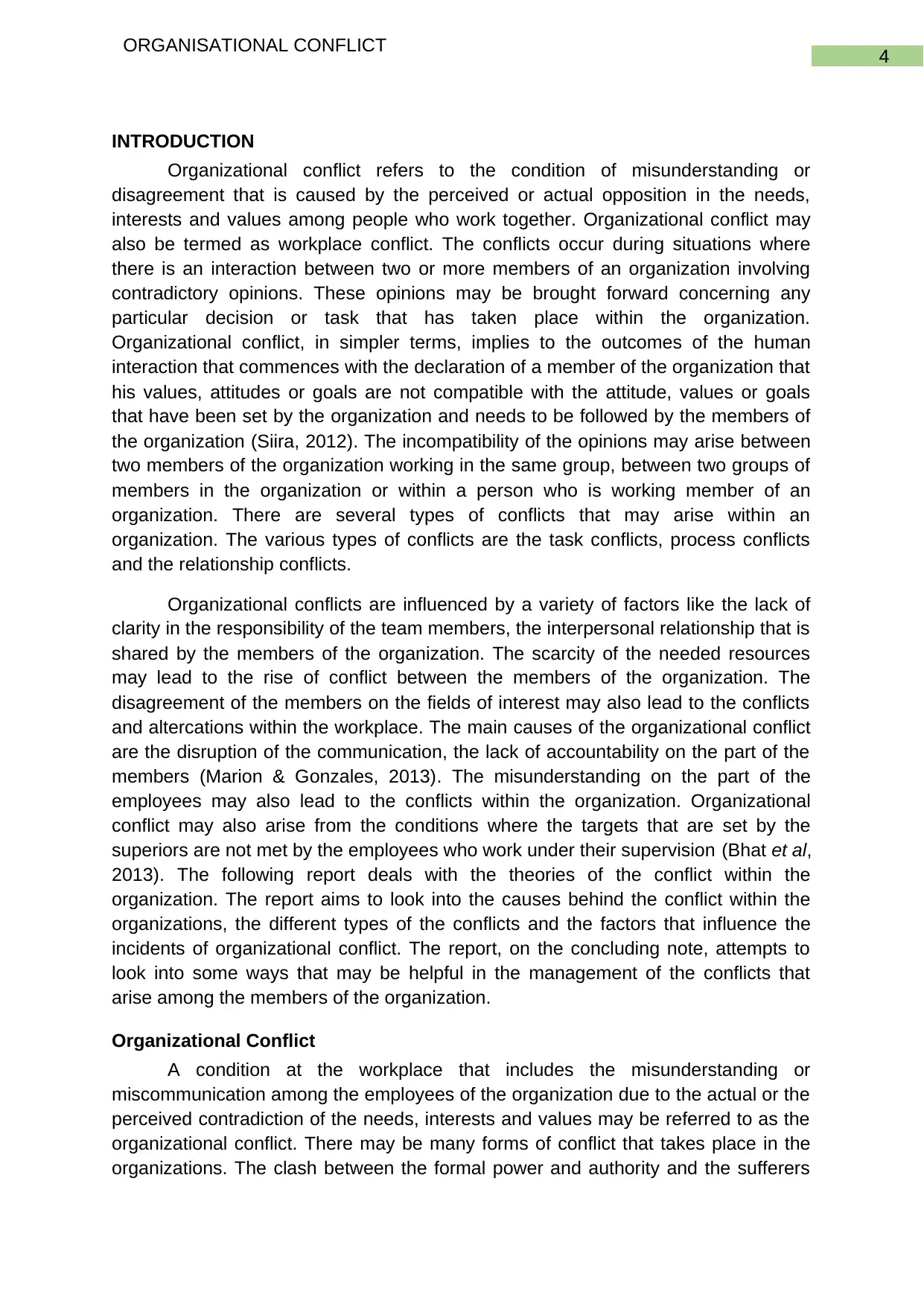
4
ORGANISATIONAL CONFLICT
INTRODUCTION
Organizational conflict refers to the condition of misunderstanding or
disagreement that is caused by the perceived or actual opposition in the needs,
interests and values among people who work together. Organizational conflict may
also be termed as workplace conflict. The conflicts occur during situations where
there is an interaction between two or more members of an organization involving
contradictory opinions. These opinions may be brought forward concerning any
particular decision or task that has taken place within the organization.
Organizational conflict, in simpler terms, implies to the outcomes of the human
interaction that commences with the declaration of a member of the organization that
his values, attitudes or goals are not compatible with the attitude, values or goals
that have been set by the organization and needs to be followed by the members of
the organization (Siira, 2012). The incompatibility of the opinions may arise between
two members of the organization working in the same group, between two groups of
members in the organization or within a person who is working member of an
organization. There are several types of conflicts that may arise within an
organization. The various types of conflicts are the task conflicts, process conflicts
and the relationship conflicts.
Organizational conflicts are influenced by a variety of factors like the lack of
clarity in the responsibility of the team members, the interpersonal relationship that is
shared by the members of the organization. The scarcity of the needed resources
may lead to the rise of conflict between the members of the organization. The
disagreement of the members on the fields of interest may also lead to the conflicts
and altercations within the workplace. The main causes of the organizational conflict
are the disruption of the communication, the lack of accountability on the part of the
members (Marion & Gonzales, 2013). The misunderstanding on the part of the
employees may also lead to the conflicts within the organization. Organizational
conflict may also arise from the conditions where the targets that are set by the
superiors are not met by the employees who work under their supervision (Bhat et al,
2013). The following report deals with the theories of the conflict within the
organization. The report aims to look into the causes behind the conflict within the
organizations, the different types of the conflicts and the factors that influence the
incidents of organizational conflict. The report, on the concluding note, attempts to
look into some ways that may be helpful in the management of the conflicts that
arise among the members of the organization.
Organizational Conflict
A condition at the workplace that includes the misunderstanding or
miscommunication among the employees of the organization due to the actual or the
perceived contradiction of the needs, interests and values may be referred to as the
organizational conflict. There may be many forms of conflict that takes place in the
organizations. The clash between the formal power and authority and the sufferers
ORGANISATIONAL CONFLICT
INTRODUCTION
Organizational conflict refers to the condition of misunderstanding or
disagreement that is caused by the perceived or actual opposition in the needs,
interests and values among people who work together. Organizational conflict may
also be termed as workplace conflict. The conflicts occur during situations where
there is an interaction between two or more members of an organization involving
contradictory opinions. These opinions may be brought forward concerning any
particular decision or task that has taken place within the organization.
Organizational conflict, in simpler terms, implies to the outcomes of the human
interaction that commences with the declaration of a member of the organization that
his values, attitudes or goals are not compatible with the attitude, values or goals
that have been set by the organization and needs to be followed by the members of
the organization (Siira, 2012). The incompatibility of the opinions may arise between
two members of the organization working in the same group, between two groups of
members in the organization or within a person who is working member of an
organization. There are several types of conflicts that may arise within an
organization. The various types of conflicts are the task conflicts, process conflicts
and the relationship conflicts.
Organizational conflicts are influenced by a variety of factors like the lack of
clarity in the responsibility of the team members, the interpersonal relationship that is
shared by the members of the organization. The scarcity of the needed resources
may lead to the rise of conflict between the members of the organization. The
disagreement of the members on the fields of interest may also lead to the conflicts
and altercations within the workplace. The main causes of the organizational conflict
are the disruption of the communication, the lack of accountability on the part of the
members (Marion & Gonzales, 2013). The misunderstanding on the part of the
employees may also lead to the conflicts within the organization. Organizational
conflict may also arise from the conditions where the targets that are set by the
superiors are not met by the employees who work under their supervision (Bhat et al,
2013). The following report deals with the theories of the conflict within the
organization. The report aims to look into the causes behind the conflict within the
organizations, the different types of the conflicts and the factors that influence the
incidents of organizational conflict. The report, on the concluding note, attempts to
look into some ways that may be helpful in the management of the conflicts that
arise among the members of the organization.
Organizational Conflict
A condition at the workplace that includes the misunderstanding or
miscommunication among the employees of the organization due to the actual or the
perceived contradiction of the needs, interests and values may be referred to as the
organizational conflict. There may be many forms of conflict that takes place in the
organizations. The clash between the formal power and authority and the sufferers
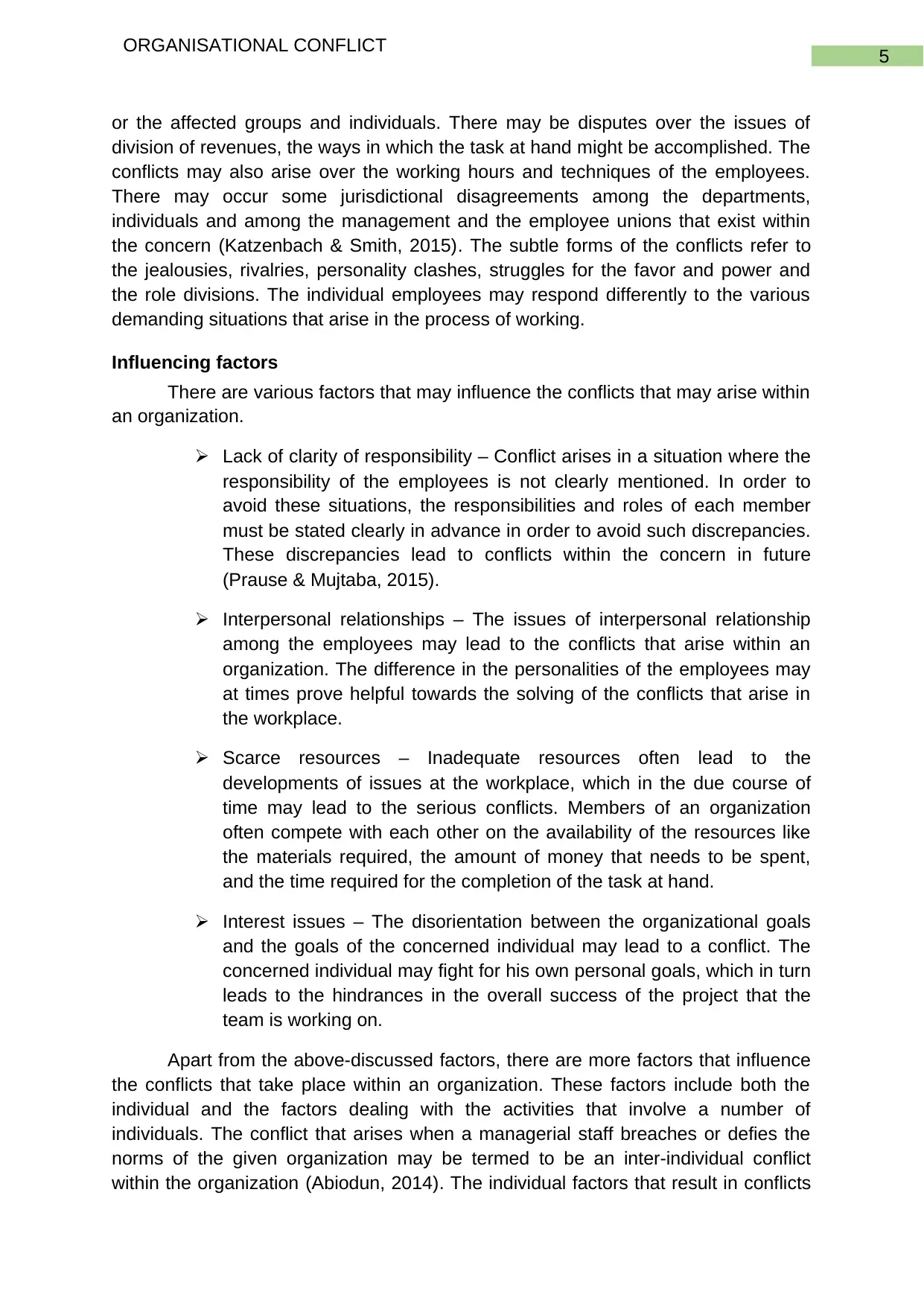
5
ORGANISATIONAL CONFLICT
or the affected groups and individuals. There may be disputes over the issues of
division of revenues, the ways in which the task at hand might be accomplished. The
conflicts may also arise over the working hours and techniques of the employees.
There may occur some jurisdictional disagreements among the departments,
individuals and among the management and the employee unions that exist within
the concern (Katzenbach & Smith, 2015). The subtle forms of the conflicts refer to
the jealousies, rivalries, personality clashes, struggles for the favor and power and
the role divisions. The individual employees may respond differently to the various
demanding situations that arise in the process of working.
Influencing factors
There are various factors that may influence the conflicts that may arise within
an organization.
Lack of clarity of responsibility – Conflict arises in a situation where the
responsibility of the employees is not clearly mentioned. In order to
avoid these situations, the responsibilities and roles of each member
must be stated clearly in advance in order to avoid such discrepancies.
These discrepancies lead to conflicts within the concern in future
(Prause & Mujtaba, 2015).
Interpersonal relationships – The issues of interpersonal relationship
among the employees may lead to the conflicts that arise within an
organization. The difference in the personalities of the employees may
at times prove helpful towards the solving of the conflicts that arise in
the workplace.
Scarce resources – Inadequate resources often lead to the
developments of issues at the workplace, which in the due course of
time may lead to the serious conflicts. Members of an organization
often compete with each other on the availability of the resources like
the materials required, the amount of money that needs to be spent,
and the time required for the completion of the task at hand.
Interest issues – The disorientation between the organizational goals
and the goals of the concerned individual may lead to a conflict. The
concerned individual may fight for his own personal goals, which in turn
leads to the hindrances in the overall success of the project that the
team is working on.
Apart from the above-discussed factors, there are more factors that influence
the conflicts that take place within an organization. These factors include both the
individual and the factors dealing with the activities that involve a number of
individuals. The conflict that arises when a managerial staff breaches or defies the
norms of the given organization may be termed to be an inter-individual conflict
within the organization (Abiodun, 2014). The individual factors that result in conflicts
ORGANISATIONAL CONFLICT
or the affected groups and individuals. There may be disputes over the issues of
division of revenues, the ways in which the task at hand might be accomplished. The
conflicts may also arise over the working hours and techniques of the employees.
There may occur some jurisdictional disagreements among the departments,
individuals and among the management and the employee unions that exist within
the concern (Katzenbach & Smith, 2015). The subtle forms of the conflicts refer to
the jealousies, rivalries, personality clashes, struggles for the favor and power and
the role divisions. The individual employees may respond differently to the various
demanding situations that arise in the process of working.
Influencing factors
There are various factors that may influence the conflicts that may arise within
an organization.
Lack of clarity of responsibility – Conflict arises in a situation where the
responsibility of the employees is not clearly mentioned. In order to
avoid these situations, the responsibilities and roles of each member
must be stated clearly in advance in order to avoid such discrepancies.
These discrepancies lead to conflicts within the concern in future
(Prause & Mujtaba, 2015).
Interpersonal relationships – The issues of interpersonal relationship
among the employees may lead to the conflicts that arise within an
organization. The difference in the personalities of the employees may
at times prove helpful towards the solving of the conflicts that arise in
the workplace.
Scarce resources – Inadequate resources often lead to the
developments of issues at the workplace, which in the due course of
time may lead to the serious conflicts. Members of an organization
often compete with each other on the availability of the resources like
the materials required, the amount of money that needs to be spent,
and the time required for the completion of the task at hand.
Interest issues – The disorientation between the organizational goals
and the goals of the concerned individual may lead to a conflict. The
concerned individual may fight for his own personal goals, which in turn
leads to the hindrances in the overall success of the project that the
team is working on.
Apart from the above-discussed factors, there are more factors that influence
the conflicts that take place within an organization. These factors include both the
individual and the factors dealing with the activities that involve a number of
individuals. The conflict that arises when a managerial staff breaches or defies the
norms of the given organization may be termed to be an inter-individual conflict
within the organization (Abiodun, 2014). The individual factors that result in conflicts
⊘ This is a preview!⊘
Do you want full access?
Subscribe today to unlock all pages.

Trusted by 1+ million students worldwide
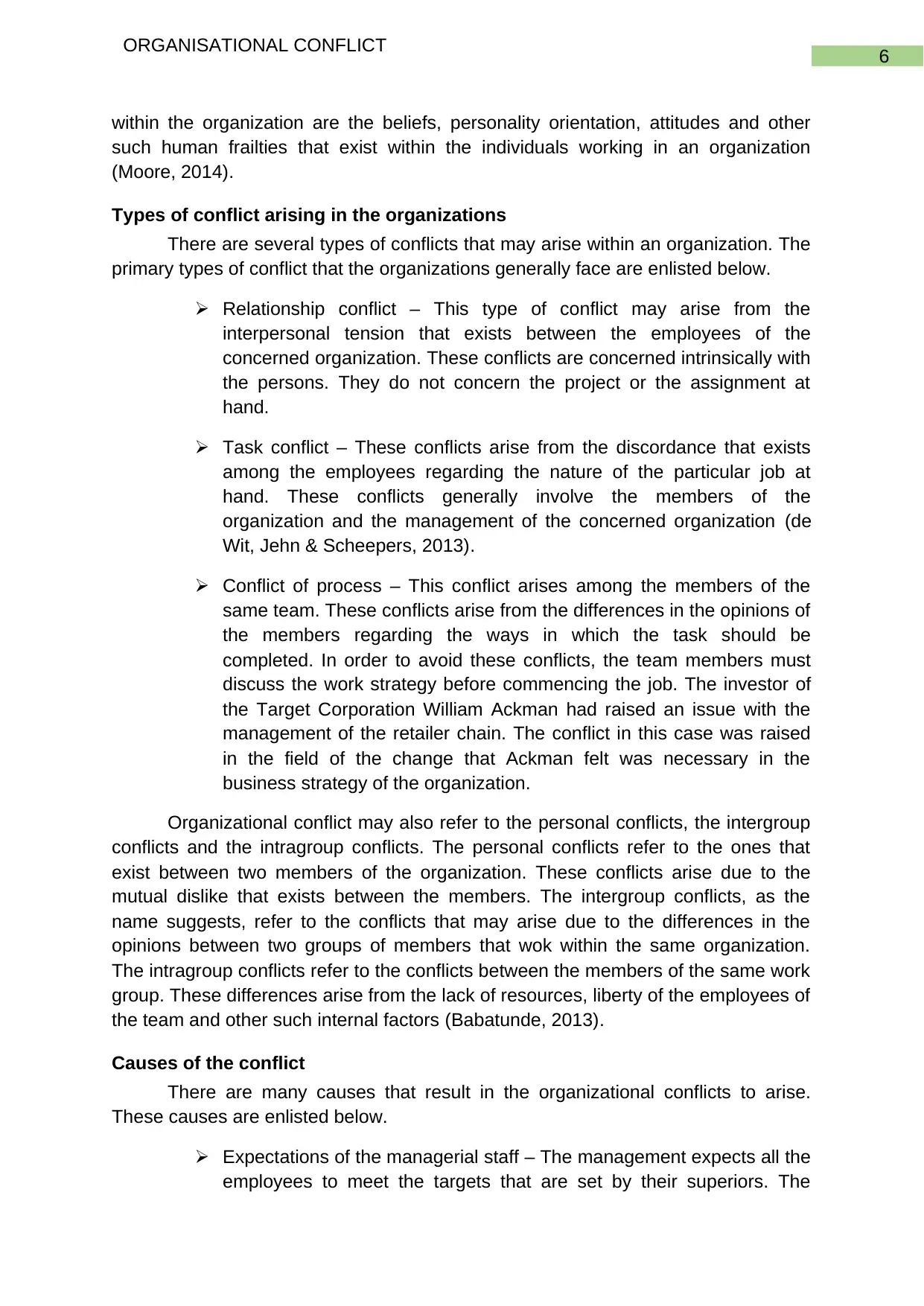
6
ORGANISATIONAL CONFLICT
within the organization are the beliefs, personality orientation, attitudes and other
such human frailties that exist within the individuals working in an organization
(Moore, 2014).
Types of conflict arising in the organizations
There are several types of conflicts that may arise within an organization. The
primary types of conflict that the organizations generally face are enlisted below.
Relationship conflict – This type of conflict may arise from the
interpersonal tension that exists between the employees of the
concerned organization. These conflicts are concerned intrinsically with
the persons. They do not concern the project or the assignment at
hand.
Task conflict – These conflicts arise from the discordance that exists
among the employees regarding the nature of the particular job at
hand. These conflicts generally involve the members of the
organization and the management of the concerned organization (de
Wit, Jehn & Scheepers, 2013).
Conflict of process – This conflict arises among the members of the
same team. These conflicts arise from the differences in the opinions of
the members regarding the ways in which the task should be
completed. In order to avoid these conflicts, the team members must
discuss the work strategy before commencing the job. The investor of
the Target Corporation William Ackman had raised an issue with the
management of the retailer chain. The conflict in this case was raised
in the field of the change that Ackman felt was necessary in the
business strategy of the organization.
Organizational conflict may also refer to the personal conflicts, the intergroup
conflicts and the intragroup conflicts. The personal conflicts refer to the ones that
exist between two members of the organization. These conflicts arise due to the
mutual dislike that exists between the members. The intergroup conflicts, as the
name suggests, refer to the conflicts that may arise due to the differences in the
opinions between two groups of members that wok within the same organization.
The intragroup conflicts refer to the conflicts between the members of the same work
group. These differences arise from the lack of resources, liberty of the employees of
the team and other such internal factors (Babatunde, 2013).
Causes of the conflict
There are many causes that result in the organizational conflicts to arise.
These causes are enlisted below.
Expectations of the managerial staff – The management expects all the
employees to meet the targets that are set by their superiors. The
ORGANISATIONAL CONFLICT
within the organization are the beliefs, personality orientation, attitudes and other
such human frailties that exist within the individuals working in an organization
(Moore, 2014).
Types of conflict arising in the organizations
There are several types of conflicts that may arise within an organization. The
primary types of conflict that the organizations generally face are enlisted below.
Relationship conflict – This type of conflict may arise from the
interpersonal tension that exists between the employees of the
concerned organization. These conflicts are concerned intrinsically with
the persons. They do not concern the project or the assignment at
hand.
Task conflict – These conflicts arise from the discordance that exists
among the employees regarding the nature of the particular job at
hand. These conflicts generally involve the members of the
organization and the management of the concerned organization (de
Wit, Jehn & Scheepers, 2013).
Conflict of process – This conflict arises among the members of the
same team. These conflicts arise from the differences in the opinions of
the members regarding the ways in which the task should be
completed. In order to avoid these conflicts, the team members must
discuss the work strategy before commencing the job. The investor of
the Target Corporation William Ackman had raised an issue with the
management of the retailer chain. The conflict in this case was raised
in the field of the change that Ackman felt was necessary in the
business strategy of the organization.
Organizational conflict may also refer to the personal conflicts, the intergroup
conflicts and the intragroup conflicts. The personal conflicts refer to the ones that
exist between two members of the organization. These conflicts arise due to the
mutual dislike that exists between the members. The intergroup conflicts, as the
name suggests, refer to the conflicts that may arise due to the differences in the
opinions between two groups of members that wok within the same organization.
The intragroup conflicts refer to the conflicts between the members of the same work
group. These differences arise from the lack of resources, liberty of the employees of
the team and other such internal factors (Babatunde, 2013).
Causes of the conflict
There are many causes that result in the organizational conflicts to arise.
These causes are enlisted below.
Expectations of the managerial staff – The management expects all the
employees to meet the targets that are set by their superiors. The
Paraphrase This Document
Need a fresh take? Get an instant paraphrase of this document with our AI Paraphraser
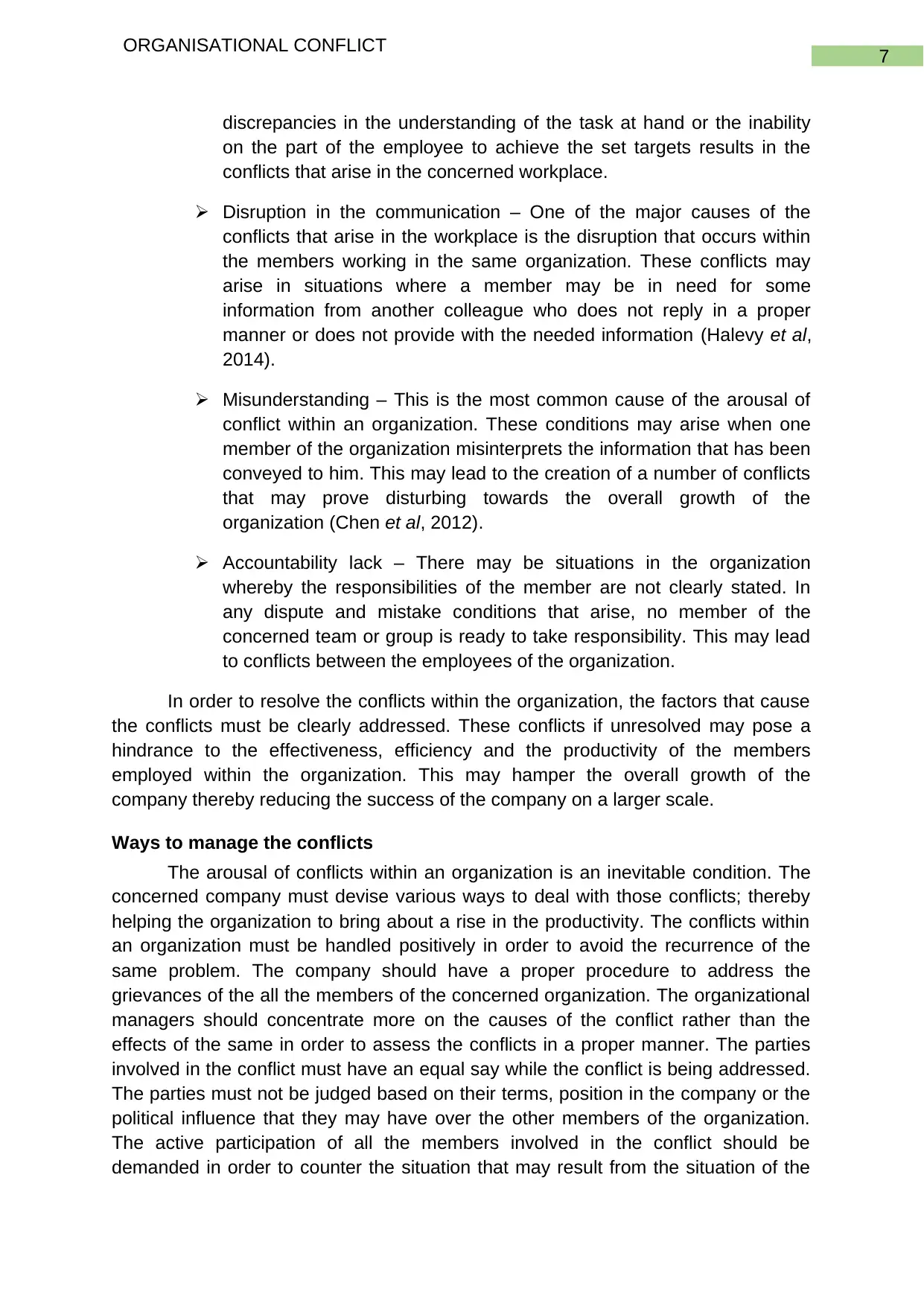
7
ORGANISATIONAL CONFLICT
discrepancies in the understanding of the task at hand or the inability
on the part of the employee to achieve the set targets results in the
conflicts that arise in the concerned workplace.
Disruption in the communication – One of the major causes of the
conflicts that arise in the workplace is the disruption that occurs within
the members working in the same organization. These conflicts may
arise in situations where a member may be in need for some
information from another colleague who does not reply in a proper
manner or does not provide with the needed information (Halevy et al,
2014).
Misunderstanding – This is the most common cause of the arousal of
conflict within an organization. These conditions may arise when one
member of the organization misinterprets the information that has been
conveyed to him. This may lead to the creation of a number of conflicts
that may prove disturbing towards the overall growth of the
organization (Chen et al, 2012).
Accountability lack – There may be situations in the organization
whereby the responsibilities of the member are not clearly stated. In
any dispute and mistake conditions that arise, no member of the
concerned team or group is ready to take responsibility. This may lead
to conflicts between the employees of the organization.
In order to resolve the conflicts within the organization, the factors that cause
the conflicts must be clearly addressed. These conflicts if unresolved may pose a
hindrance to the effectiveness, efficiency and the productivity of the members
employed within the organization. This may hamper the overall growth of the
company thereby reducing the success of the company on a larger scale.
Ways to manage the conflicts
The arousal of conflicts within an organization is an inevitable condition. The
concerned company must devise various ways to deal with those conflicts; thereby
helping the organization to bring about a rise in the productivity. The conflicts within
an organization must be handled positively in order to avoid the recurrence of the
same problem. The company should have a proper procedure to address the
grievances of the all the members of the concerned organization. The organizational
managers should concentrate more on the causes of the conflict rather than the
effects of the same in order to assess the conflicts in a proper manner. The parties
involved in the conflict must have an equal say while the conflict is being addressed.
The parties must not be judged based on their terms, position in the company or the
political influence that they may have over the other members of the organization.
The active participation of all the members involved in the conflict should be
demanded in order to counter the situation that may result from the situation of the
ORGANISATIONAL CONFLICT
discrepancies in the understanding of the task at hand or the inability
on the part of the employee to achieve the set targets results in the
conflicts that arise in the concerned workplace.
Disruption in the communication – One of the major causes of the
conflicts that arise in the workplace is the disruption that occurs within
the members working in the same organization. These conflicts may
arise in situations where a member may be in need for some
information from another colleague who does not reply in a proper
manner or does not provide with the needed information (Halevy et al,
2014).
Misunderstanding – This is the most common cause of the arousal of
conflict within an organization. These conditions may arise when one
member of the organization misinterprets the information that has been
conveyed to him. This may lead to the creation of a number of conflicts
that may prove disturbing towards the overall growth of the
organization (Chen et al, 2012).
Accountability lack – There may be situations in the organization
whereby the responsibilities of the member are not clearly stated. In
any dispute and mistake conditions that arise, no member of the
concerned team or group is ready to take responsibility. This may lead
to conflicts between the employees of the organization.
In order to resolve the conflicts within the organization, the factors that cause
the conflicts must be clearly addressed. These conflicts if unresolved may pose a
hindrance to the effectiveness, efficiency and the productivity of the members
employed within the organization. This may hamper the overall growth of the
company thereby reducing the success of the company on a larger scale.
Ways to manage the conflicts
The arousal of conflicts within an organization is an inevitable condition. The
concerned company must devise various ways to deal with those conflicts; thereby
helping the organization to bring about a rise in the productivity. The conflicts within
an organization must be handled positively in order to avoid the recurrence of the
same problem. The company should have a proper procedure to address the
grievances of the all the members of the concerned organization. The organizational
managers should concentrate more on the causes of the conflict rather than the
effects of the same in order to assess the conflicts in a proper manner. The parties
involved in the conflict must have an equal say while the conflict is being addressed.
The parties must not be judged based on their terms, position in the company or the
political influence that they may have over the other members of the organization.
The active participation of all the members involved in the conflict should be
demanded in order to counter the situation that may result from the situation of the
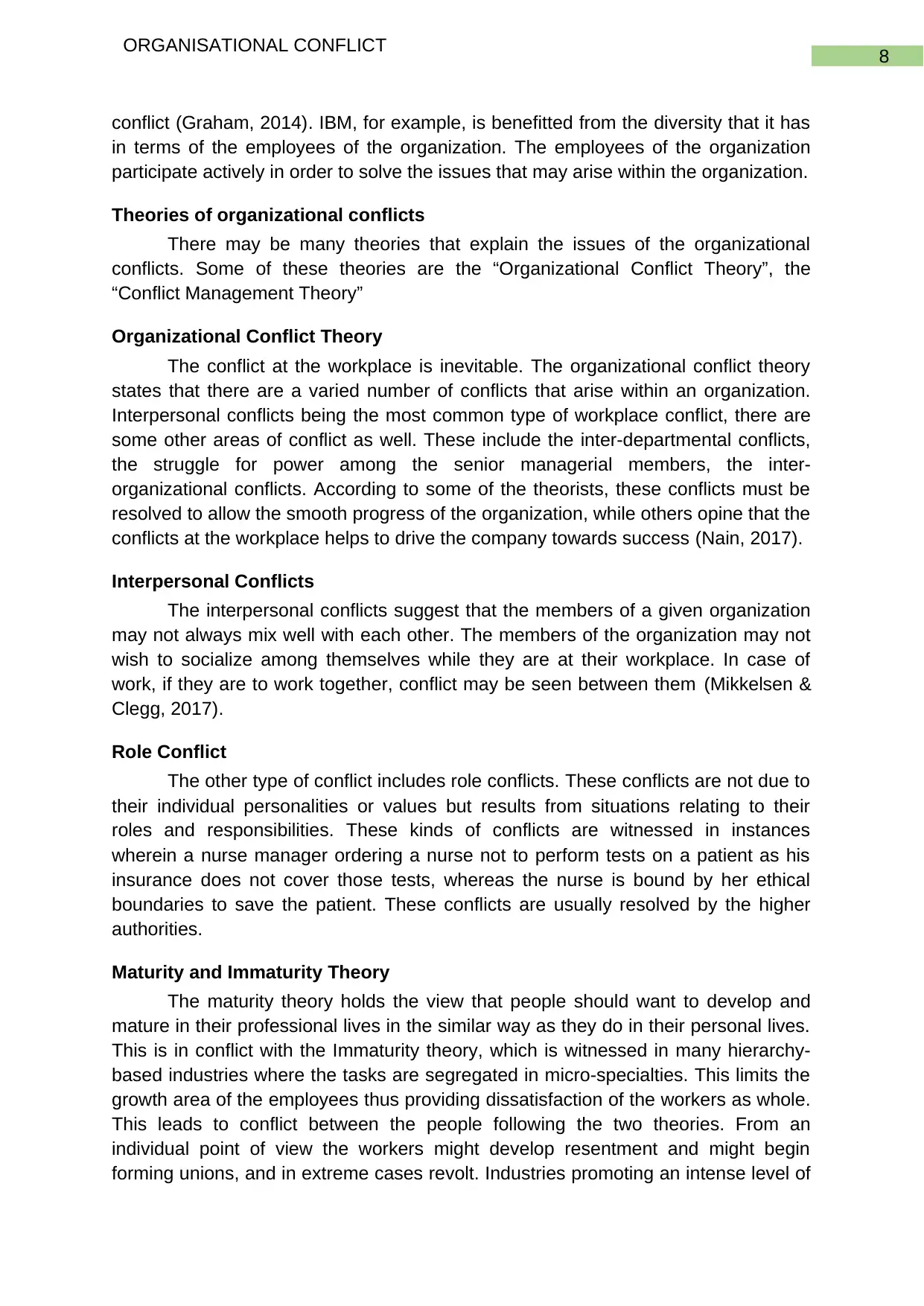
8
ORGANISATIONAL CONFLICT
conflict (Graham, 2014). IBM, for example, is benefitted from the diversity that it has
in terms of the employees of the organization. The employees of the organization
participate actively in order to solve the issues that may arise within the organization.
Theories of organizational conflicts
There may be many theories that explain the issues of the organizational
conflicts. Some of these theories are the “Organizational Conflict Theory”, the
“Conflict Management Theory”
Organizational Conflict Theory
The conflict at the workplace is inevitable. The organizational conflict theory
states that there are a varied number of conflicts that arise within an organization.
Interpersonal conflicts being the most common type of workplace conflict, there are
some other areas of conflict as well. These include the inter-departmental conflicts,
the struggle for power among the senior managerial members, the inter-
organizational conflicts. According to some of the theorists, these conflicts must be
resolved to allow the smooth progress of the organization, while others opine that the
conflicts at the workplace helps to drive the company towards success (Nain, 2017).
Interpersonal Conflicts
The interpersonal conflicts suggest that the members of a given organization
may not always mix well with each other. The members of the organization may not
wish to socialize among themselves while they are at their workplace. In case of
work, if they are to work together, conflict may be seen between them (Mikkelsen &
Clegg, 2017).
Role Conflict
The other type of conflict includes role conflicts. These conflicts are not due to
their individual personalities or values but results from situations relating to their
roles and responsibilities. These kinds of conflicts are witnessed in instances
wherein a nurse manager ordering a nurse not to perform tests on a patient as his
insurance does not cover those tests, whereas the nurse is bound by her ethical
boundaries to save the patient. These conflicts are usually resolved by the higher
authorities.
Maturity and Immaturity Theory
The maturity theory holds the view that people should want to develop and
mature in their professional lives in the similar way as they do in their personal lives.
This is in conflict with the Immaturity theory, which is witnessed in many hierarchy-
based industries where the tasks are segregated in micro-specialties. This limits the
growth area of the employees thus providing dissatisfaction of the workers as whole.
This leads to conflict between the people following the two theories. From an
individual point of view the workers might develop resentment and might begin
forming unions, and in extreme cases revolt. Industries promoting an intense level of
ORGANISATIONAL CONFLICT
conflict (Graham, 2014). IBM, for example, is benefitted from the diversity that it has
in terms of the employees of the organization. The employees of the organization
participate actively in order to solve the issues that may arise within the organization.
Theories of organizational conflicts
There may be many theories that explain the issues of the organizational
conflicts. Some of these theories are the “Organizational Conflict Theory”, the
“Conflict Management Theory”
Organizational Conflict Theory
The conflict at the workplace is inevitable. The organizational conflict theory
states that there are a varied number of conflicts that arise within an organization.
Interpersonal conflicts being the most common type of workplace conflict, there are
some other areas of conflict as well. These include the inter-departmental conflicts,
the struggle for power among the senior managerial members, the inter-
organizational conflicts. According to some of the theorists, these conflicts must be
resolved to allow the smooth progress of the organization, while others opine that the
conflicts at the workplace helps to drive the company towards success (Nain, 2017).
Interpersonal Conflicts
The interpersonal conflicts suggest that the members of a given organization
may not always mix well with each other. The members of the organization may not
wish to socialize among themselves while they are at their workplace. In case of
work, if they are to work together, conflict may be seen between them (Mikkelsen &
Clegg, 2017).
Role Conflict
The other type of conflict includes role conflicts. These conflicts are not due to
their individual personalities or values but results from situations relating to their
roles and responsibilities. These kinds of conflicts are witnessed in instances
wherein a nurse manager ordering a nurse not to perform tests on a patient as his
insurance does not cover those tests, whereas the nurse is bound by her ethical
boundaries to save the patient. These conflicts are usually resolved by the higher
authorities.
Maturity and Immaturity Theory
The maturity theory holds the view that people should want to develop and
mature in their professional lives in the similar way as they do in their personal lives.
This is in conflict with the Immaturity theory, which is witnessed in many hierarchy-
based industries where the tasks are segregated in micro-specialties. This limits the
growth area of the employees thus providing dissatisfaction of the workers as whole.
This leads to conflict between the people following the two theories. From an
individual point of view the workers might develop resentment and might begin
forming unions, and in extreme cases revolt. Industries promoting an intense level of
⊘ This is a preview!⊘
Do you want full access?
Subscribe today to unlock all pages.

Trusted by 1+ million students worldwide
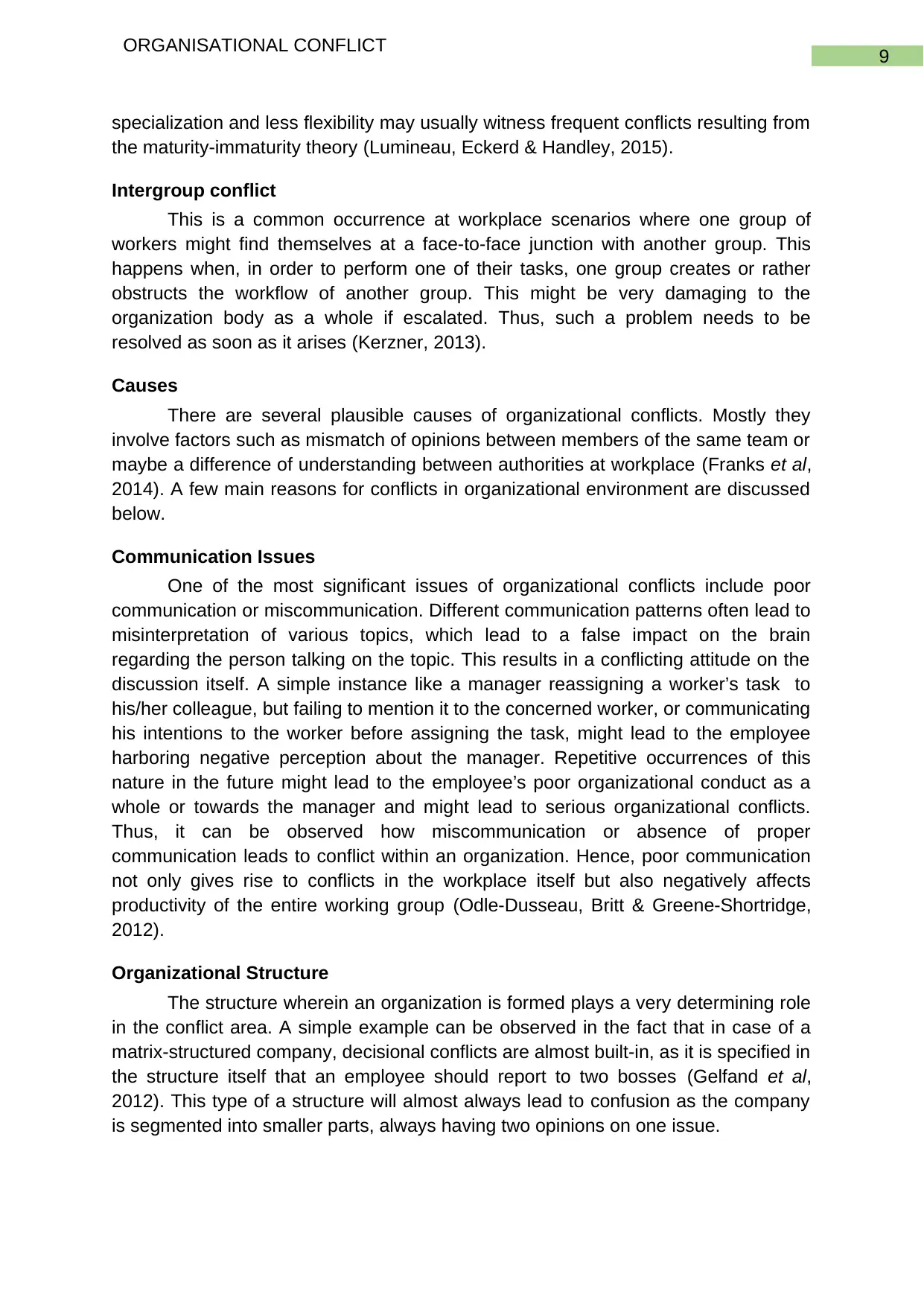
9
ORGANISATIONAL CONFLICT
specialization and less flexibility may usually witness frequent conflicts resulting from
the maturity-immaturity theory (Lumineau, Eckerd & Handley, 2015).
Intergroup conflict
This is a common occurrence at workplace scenarios where one group of
workers might find themselves at a face-to-face junction with another group. This
happens when, in order to perform one of their tasks, one group creates or rather
obstructs the workflow of another group. This might be very damaging to the
organization body as a whole if escalated. Thus, such a problem needs to be
resolved as soon as it arises (Kerzner, 2013).
Causes
There are several plausible causes of organizational conflicts. Mostly they
involve factors such as mismatch of opinions between members of the same team or
maybe a difference of understanding between authorities at workplace (Franks et al,
2014). A few main reasons for conflicts in organizational environment are discussed
below.
Communication Issues
One of the most significant issues of organizational conflicts include poor
communication or miscommunication. Different communication patterns often lead to
misinterpretation of various topics, which lead to a false impact on the brain
regarding the person talking on the topic. This results in a conflicting attitude on the
discussion itself. A simple instance like a manager reassigning a worker’s task to
his/her colleague, but failing to mention it to the concerned worker, or communicating
his intentions to the worker before assigning the task, might lead to the employee
harboring negative perception about the manager. Repetitive occurrences of this
nature in the future might lead to the employee’s poor organizational conduct as a
whole or towards the manager and might lead to serious organizational conflicts.
Thus, it can be observed how miscommunication or absence of proper
communication leads to conflict within an organization. Hence, poor communication
not only gives rise to conflicts in the workplace itself but also negatively affects
productivity of the entire working group (Odle-Dusseau, Britt & Greene-Shortridge,
2012).
Organizational Structure
The structure wherein an organization is formed plays a very determining role
in the conflict area. A simple example can be observed in the fact that in case of a
matrix-structured company, decisional conflicts are almost built-in, as it is specified in
the structure itself that an employee should report to two bosses (Gelfand et al,
2012). This type of a structure will almost always lead to confusion as the company
is segmented into smaller parts, always having two opinions on one issue.
ORGANISATIONAL CONFLICT
specialization and less flexibility may usually witness frequent conflicts resulting from
the maturity-immaturity theory (Lumineau, Eckerd & Handley, 2015).
Intergroup conflict
This is a common occurrence at workplace scenarios where one group of
workers might find themselves at a face-to-face junction with another group. This
happens when, in order to perform one of their tasks, one group creates or rather
obstructs the workflow of another group. This might be very damaging to the
organization body as a whole if escalated. Thus, such a problem needs to be
resolved as soon as it arises (Kerzner, 2013).
Causes
There are several plausible causes of organizational conflicts. Mostly they
involve factors such as mismatch of opinions between members of the same team or
maybe a difference of understanding between authorities at workplace (Franks et al,
2014). A few main reasons for conflicts in organizational environment are discussed
below.
Communication Issues
One of the most significant issues of organizational conflicts include poor
communication or miscommunication. Different communication patterns often lead to
misinterpretation of various topics, which lead to a false impact on the brain
regarding the person talking on the topic. This results in a conflicting attitude on the
discussion itself. A simple instance like a manager reassigning a worker’s task to
his/her colleague, but failing to mention it to the concerned worker, or communicating
his intentions to the worker before assigning the task, might lead to the employee
harboring negative perception about the manager. Repetitive occurrences of this
nature in the future might lead to the employee’s poor organizational conduct as a
whole or towards the manager and might lead to serious organizational conflicts.
Thus, it can be observed how miscommunication or absence of proper
communication leads to conflict within an organization. Hence, poor communication
not only gives rise to conflicts in the workplace itself but also negatively affects
productivity of the entire working group (Odle-Dusseau, Britt & Greene-Shortridge,
2012).
Organizational Structure
The structure wherein an organization is formed plays a very determining role
in the conflict area. A simple example can be observed in the fact that in case of a
matrix-structured company, decisional conflicts are almost built-in, as it is specified in
the structure itself that an employee should report to two bosses (Gelfand et al,
2012). This type of a structure will almost always lead to confusion as the company
is segmented into smaller parts, always having two opinions on one issue.
Paraphrase This Document
Need a fresh take? Get an instant paraphrase of this document with our AI Paraphraser
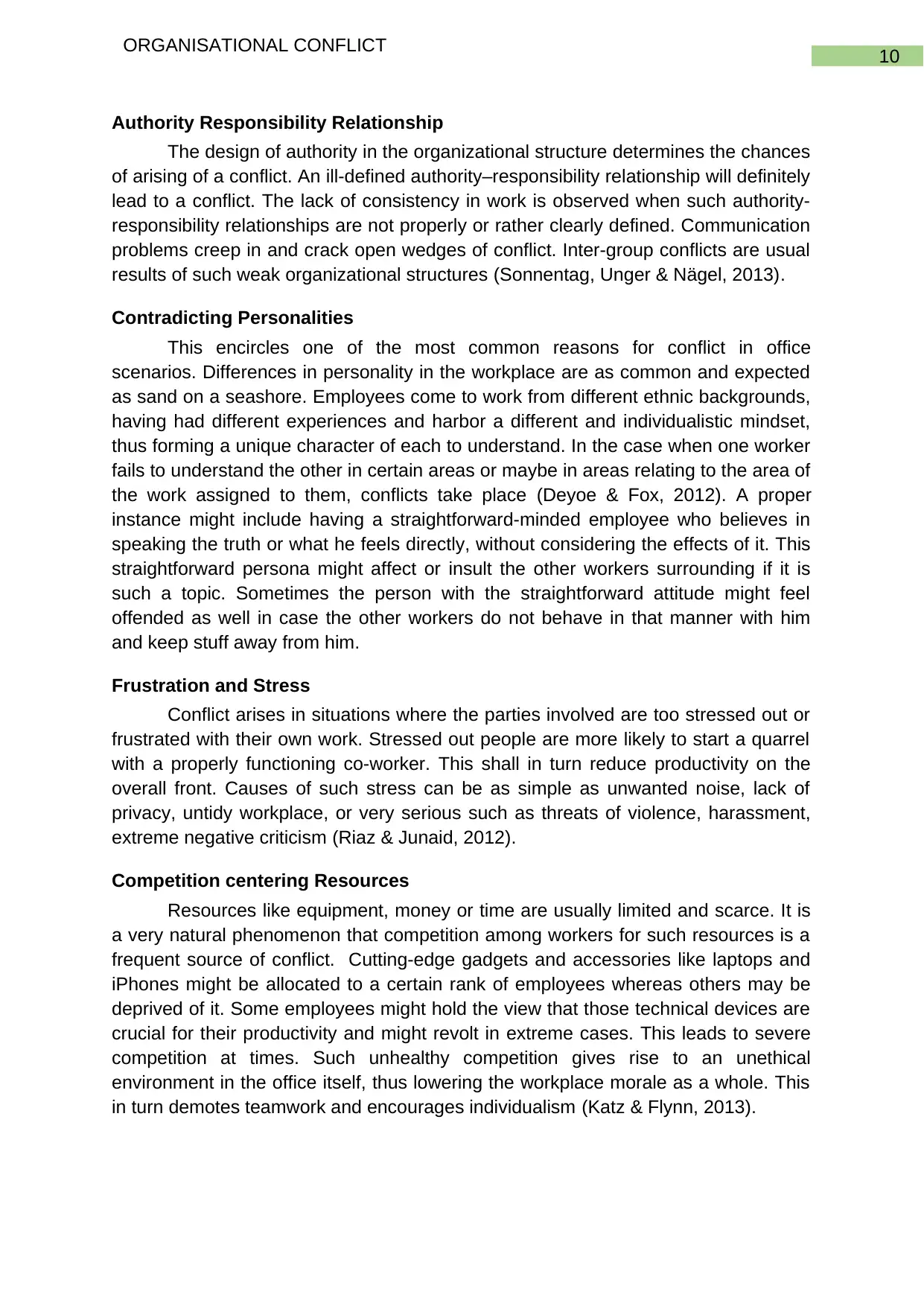
10
ORGANISATIONAL CONFLICT
Authority Responsibility Relationship
The design of authority in the organizational structure determines the chances
of arising of a conflict. An ill-defined authority–responsibility relationship will definitely
lead to a conflict. The lack of consistency in work is observed when such authority-
responsibility relationships are not properly or rather clearly defined. Communication
problems creep in and crack open wedges of conflict. Inter-group conflicts are usual
results of such weak organizational structures (Sonnentag, Unger & Nägel, 2013).
Contradicting Personalities
This encircles one of the most common reasons for conflict in office
scenarios. Differences in personality in the workplace are as common and expected
as sand on a seashore. Employees come to work from different ethnic backgrounds,
having had different experiences and harbor a different and individualistic mindset,
thus forming a unique character of each to understand. In the case when one worker
fails to understand the other in certain areas or maybe in areas relating to the area of
the work assigned to them, conflicts take place (Deyoe & Fox, 2012). A proper
instance might include having a straightforward-minded employee who believes in
speaking the truth or what he feels directly, without considering the effects of it. This
straightforward persona might affect or insult the other workers surrounding if it is
such a topic. Sometimes the person with the straightforward attitude might feel
offended as well in case the other workers do not behave in that manner with him
and keep stuff away from him.
Frustration and Stress
Conflict arises in situations where the parties involved are too stressed out or
frustrated with their own work. Stressed out people are more likely to start a quarrel
with a properly functioning co-worker. This shall in turn reduce productivity on the
overall front. Causes of such stress can be as simple as unwanted noise, lack of
privacy, untidy workplace, or very serious such as threats of violence, harassment,
extreme negative criticism (Riaz & Junaid, 2012).
Competition centering Resources
Resources like equipment, money or time are usually limited and scarce. It is
a very natural phenomenon that competition among workers for such resources is a
frequent source of conflict. Cutting-edge gadgets and accessories like laptops and
iPhones might be allocated to a certain rank of employees whereas others may be
deprived of it. Some employees might hold the view that those technical devices are
crucial for their productivity and might revolt in extreme cases. This leads to severe
competition at times. Such unhealthy competition gives rise to an unethical
environment in the office itself, thus lowering the workplace morale as a whole. This
in turn demotes teamwork and encourages individualism (Katz & Flynn, 2013).
ORGANISATIONAL CONFLICT
Authority Responsibility Relationship
The design of authority in the organizational structure determines the chances
of arising of a conflict. An ill-defined authority–responsibility relationship will definitely
lead to a conflict. The lack of consistency in work is observed when such authority-
responsibility relationships are not properly or rather clearly defined. Communication
problems creep in and crack open wedges of conflict. Inter-group conflicts are usual
results of such weak organizational structures (Sonnentag, Unger & Nägel, 2013).
Contradicting Personalities
This encircles one of the most common reasons for conflict in office
scenarios. Differences in personality in the workplace are as common and expected
as sand on a seashore. Employees come to work from different ethnic backgrounds,
having had different experiences and harbor a different and individualistic mindset,
thus forming a unique character of each to understand. In the case when one worker
fails to understand the other in certain areas or maybe in areas relating to the area of
the work assigned to them, conflicts take place (Deyoe & Fox, 2012). A proper
instance might include having a straightforward-minded employee who believes in
speaking the truth or what he feels directly, without considering the effects of it. This
straightforward persona might affect or insult the other workers surrounding if it is
such a topic. Sometimes the person with the straightforward attitude might feel
offended as well in case the other workers do not behave in that manner with him
and keep stuff away from him.
Frustration and Stress
Conflict arises in situations where the parties involved are too stressed out or
frustrated with their own work. Stressed out people are more likely to start a quarrel
with a properly functioning co-worker. This shall in turn reduce productivity on the
overall front. Causes of such stress can be as simple as unwanted noise, lack of
privacy, untidy workplace, or very serious such as threats of violence, harassment,
extreme negative criticism (Riaz & Junaid, 2012).
Competition centering Resources
Resources like equipment, money or time are usually limited and scarce. It is
a very natural phenomenon that competition among workers for such resources is a
frequent source of conflict. Cutting-edge gadgets and accessories like laptops and
iPhones might be allocated to a certain rank of employees whereas others may be
deprived of it. Some employees might hold the view that those technical devices are
crucial for their productivity and might revolt in extreme cases. This leads to severe
competition at times. Such unhealthy competition gives rise to an unethical
environment in the office itself, thus lowering the workplace morale as a whole. This
in turn demotes teamwork and encourages individualism (Katz & Flynn, 2013).
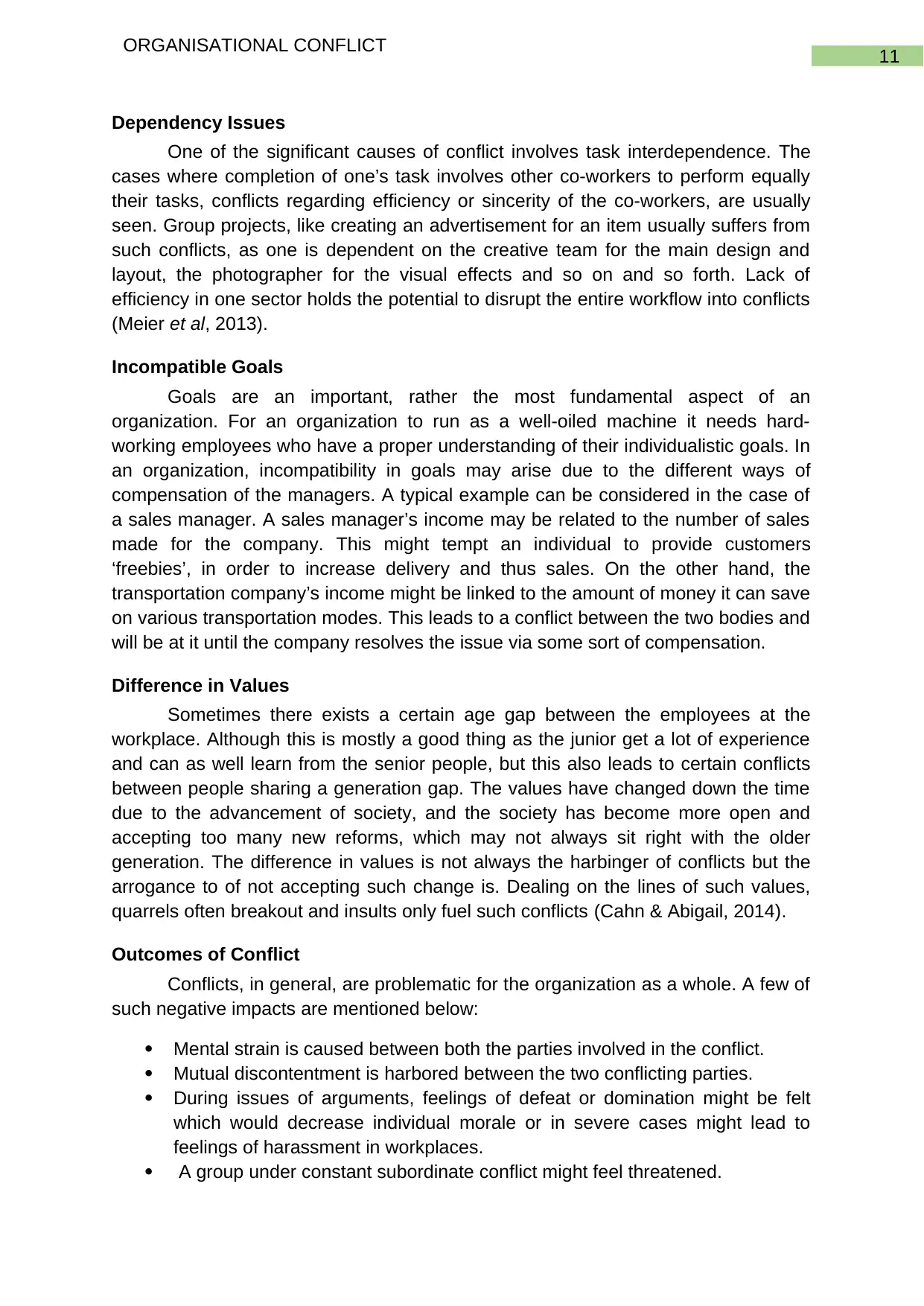
11
ORGANISATIONAL CONFLICT
Dependency Issues
One of the significant causes of conflict involves task interdependence. The
cases where completion of one’s task involves other co-workers to perform equally
their tasks, conflicts regarding efficiency or sincerity of the co-workers, are usually
seen. Group projects, like creating an advertisement for an item usually suffers from
such conflicts, as one is dependent on the creative team for the main design and
layout, the photographer for the visual effects and so on and so forth. Lack of
efficiency in one sector holds the potential to disrupt the entire workflow into conflicts
(Meier et al, 2013).
Incompatible Goals
Goals are an important, rather the most fundamental aspect of an
organization. For an organization to run as a well-oiled machine it needs hard-
working employees who have a proper understanding of their individualistic goals. In
an organization, incompatibility in goals may arise due to the different ways of
compensation of the managers. A typical example can be considered in the case of
a sales manager. A sales manager’s income may be related to the number of sales
made for the company. This might tempt an individual to provide customers
‘freebies’, in order to increase delivery and thus sales. On the other hand, the
transportation company’s income might be linked to the amount of money it can save
on various transportation modes. This leads to a conflict between the two bodies and
will be at it until the company resolves the issue via some sort of compensation.
Difference in Values
Sometimes there exists a certain age gap between the employees at the
workplace. Although this is mostly a good thing as the junior get a lot of experience
and can as well learn from the senior people, but this also leads to certain conflicts
between people sharing a generation gap. The values have changed down the time
due to the advancement of society, and the society has become more open and
accepting too many new reforms, which may not always sit right with the older
generation. The difference in values is not always the harbinger of conflicts but the
arrogance to of not accepting such change is. Dealing on the lines of such values,
quarrels often breakout and insults only fuel such conflicts (Cahn & Abigail, 2014).
Outcomes of Conflict
Conflicts, in general, are problematic for the organization as a whole. A few of
such negative impacts are mentioned below:
Mental strain is caused between both the parties involved in the conflict.
Mutual discontentment is harbored between the two conflicting parties.
During issues of arguments, feelings of defeat or domination might be felt
which would decrease individual morale or in severe cases might lead to
feelings of harassment in workplaces.
A group under constant subordinate conflict might feel threatened.
ORGANISATIONAL CONFLICT
Dependency Issues
One of the significant causes of conflict involves task interdependence. The
cases where completion of one’s task involves other co-workers to perform equally
their tasks, conflicts regarding efficiency or sincerity of the co-workers, are usually
seen. Group projects, like creating an advertisement for an item usually suffers from
such conflicts, as one is dependent on the creative team for the main design and
layout, the photographer for the visual effects and so on and so forth. Lack of
efficiency in one sector holds the potential to disrupt the entire workflow into conflicts
(Meier et al, 2013).
Incompatible Goals
Goals are an important, rather the most fundamental aspect of an
organization. For an organization to run as a well-oiled machine it needs hard-
working employees who have a proper understanding of their individualistic goals. In
an organization, incompatibility in goals may arise due to the different ways of
compensation of the managers. A typical example can be considered in the case of
a sales manager. A sales manager’s income may be related to the number of sales
made for the company. This might tempt an individual to provide customers
‘freebies’, in order to increase delivery and thus sales. On the other hand, the
transportation company’s income might be linked to the amount of money it can save
on various transportation modes. This leads to a conflict between the two bodies and
will be at it until the company resolves the issue via some sort of compensation.
Difference in Values
Sometimes there exists a certain age gap between the employees at the
workplace. Although this is mostly a good thing as the junior get a lot of experience
and can as well learn from the senior people, but this also leads to certain conflicts
between people sharing a generation gap. The values have changed down the time
due to the advancement of society, and the society has become more open and
accepting too many new reforms, which may not always sit right with the older
generation. The difference in values is not always the harbinger of conflicts but the
arrogance to of not accepting such change is. Dealing on the lines of such values,
quarrels often breakout and insults only fuel such conflicts (Cahn & Abigail, 2014).
Outcomes of Conflict
Conflicts, in general, are problematic for the organization as a whole. A few of
such negative impacts are mentioned below:
Mental strain is caused between both the parties involved in the conflict.
Mutual discontentment is harbored between the two conflicting parties.
During issues of arguments, feelings of defeat or domination might be felt
which would decrease individual morale or in severe cases might lead to
feelings of harassment in workplaces.
A group under constant subordinate conflict might feel threatened.
⊘ This is a preview!⊘
Do you want full access?
Subscribe today to unlock all pages.

Trusted by 1+ million students worldwide
1 out of 18
Related Documents
Your All-in-One AI-Powered Toolkit for Academic Success.
+13062052269
info@desklib.com
Available 24*7 on WhatsApp / Email
![[object Object]](/_next/static/media/star-bottom.7253800d.svg)
Unlock your academic potential
Copyright © 2020–2025 A2Z Services. All Rights Reserved. Developed and managed by ZUCOL.





